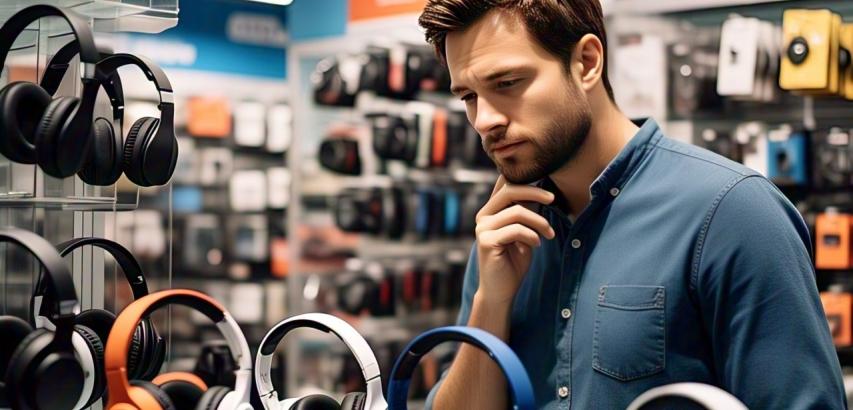Choosing the right headphones can significantly enhance your listening experience, whether for music, gaming, calls, or focused work. Here’s a step-by-step guide to help you pick the perfect pair:
Determine Your Primary Use Case
Casual Listening: Focus on comfort and balanced sound.
Commuting/Travel: Prioritize noise cancellation (active or passive) and portability.
Gaming: Look for surround sound, a built-in microphone, and low latency.
Sports/Fitness: Opt for sweat resistance, secure fit, and durability.
Studio/Professional Use: Prioritize accurate sound reproduction (flat frequency response).
Choose the Right Type
Over-Ear (Circumaural):
Pros: Best sound quality, noise isolation, comfort for long sessions.
Cons: Bulkier, less portable.
On-Ear (Supra-aural):
Pros: Compact, decent sound.
Cons: Less noise isolation, may cause ear fatigue.
In-Ear (Earbuds):
Pros: Ultra-portable, noise-isolating tips.
Cons: May feel less secure, shorter battery life (if wireless).
True Wireless (TWS):
Pros: No wires, compact charging cases.
Cons: Easy to lose, limited battery life.
Key Features to Consider
Sound Quality:
Drivers: Larger drivers (40mm+) generally deliver better bass and clarity.
Frequency Response: Look for a wide range (20Hz–20kHz for most users).
Open-Back vs. Closed-Back:
Open-Back: Natural soundstage (ideal for audiophiles) but leaks sound.
Closed-Back: Better noise isolation, suited for public use.
Noise Cancellation:
Active Noise Cancellation (ANC): Blocks external noise electronically (great for travel).
Passive Noise Isolation: Relies on physical design (ear cushion/seal).
Wireless vs. Wired:
Wireless: Convenient but requires charging (check battery life: 20+ hours ideal).
Wired: Uncompressed audio quality, no latency (better for gaming/mixing).
Microphone Quality:
Built-in mics with noise reduction are key for calls/gaming.
Comfort & Fit:
Adjustable headbands, padded ear cups, and lightweight designs.
For earbuds: Multiple ear tip sizes for a secure fit.
Durability:
Look for reinforced hinges, water resistance (IPX4+ for workouts), and replaceable parts.
Set Your Budget
Budget (<$50): Basic wired/wireless models (e.g., JBL, Skullcandy).
Mid-Range (50–50–150): Better ANC, sound, and build (e.g., Sony WH-CH720N, Jabra Elite).
Premium (150–150–300): Top-tier ANC and audio (e.g., Sony WH-1000XM5, Bose QuietComfort).
Audiophile/Pro (>$300): Studio-grade sound (e.g., Sennheiser HD 660S, Audeze LCD-1).
Brand Reputation & Warranty
Trusted Brands:
ANC/Everyday Use: Sony, Bose, Jabra.
Audiophile: Sennheiser, Audio-Technica, Beyerdynamic.
Gaming: SteelSeries, HyperX, Logitech.
Budget-Friendly: Anker Soundcore, JBL.
Warranty: Aim for at least 1–2 years of coverage.
Additional Features
Customizable EQ: Adjust sound via companion apps (e.g., Sony Headphones Connect).
Touch Controls: For volume, playback, and ANC adjustments.
Multi-Device Pairing: Switch seamlessly between phone, laptop, etc.
Low Latency Mode: Critical for gaming/video editing (look for Bluetooth 5.0+ or wired).
Test Before Buying (If Possible)
Try them on to check comfort and sound.
For online purchases, read reviews and check return policies.
Example Recommendations
Travel/ANC: Sony WH-1000XM5 (best-in-class noise cancellation).
Gaming: SteelSeries Arctis Nova Pro (surround sound, dual battery system).
Workouts: Jabra Elite 7 Active (secure fit, IP57 rating).
Audiophile: Sennheiser HD 660S (open-back, detailed sound).
Budget Wireless: Anker Soundcore Life Q30 (great ANC under $100).
Final Tips
Prioritize Your Needs: Don’t overpay for features you won’t use.
Battery Life: Wireless ANC drains faster—check real-world usage reviews.
Replaceable Parts: Ear cushions and cables should be replaceable for longevity.
By matching your lifestyle, budget, and preferences, you’ll find headphones that deliver the perfect blend of sound, comfort, and functionality. 🎧✨

